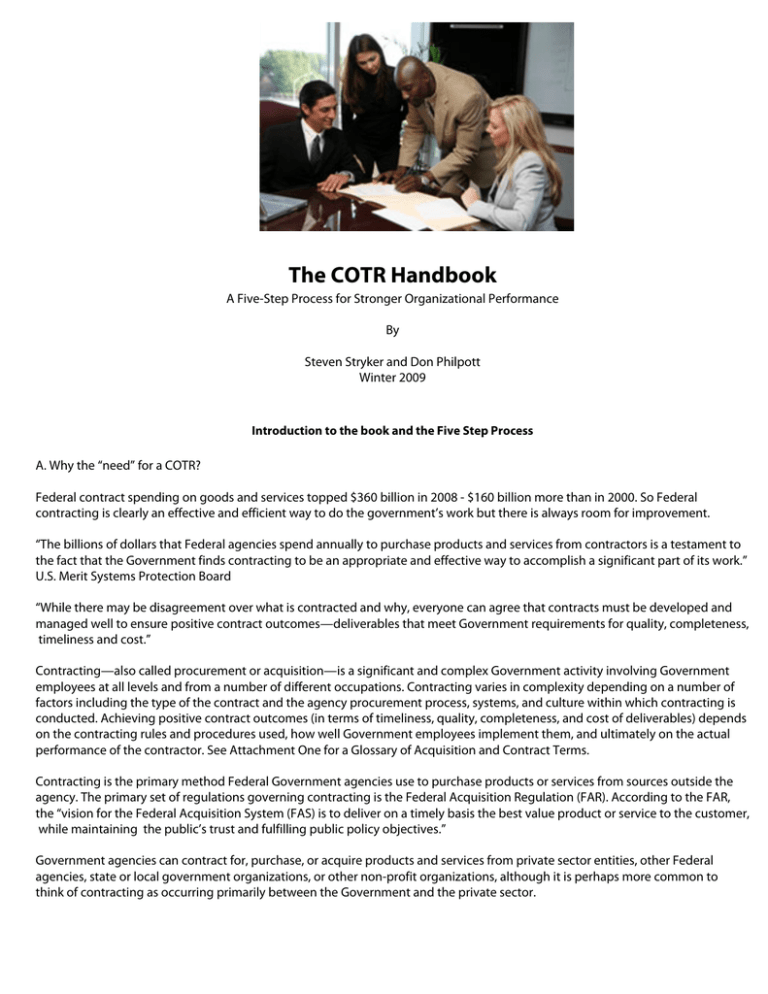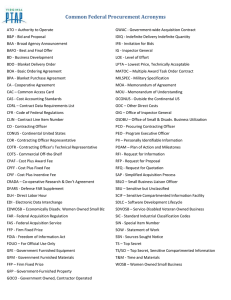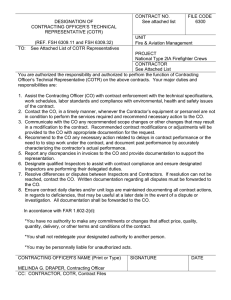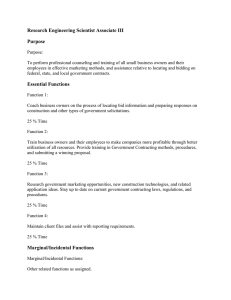The COTR Handbook - Government Training
advertisement

The COTR Handbook A Five-Step Process for Stronger Organizational Performance By Steven Stryker and Don Philpott Winter 2009 Introduction to the book and the Five Step Process A. Why the “need” for a COTR? Federal contract spending on goods and services topped $360 billion in 2008 - $160 billion more than in 2000. So Federal contracting is clearly an effective and efficient way to do the government’s work but there is always room for improvement. “The billions of dollars that Federal agencies spend annually to purchase products and services from contractors is a testament to the fact that the Government finds contracting to be an appropriate and effective way to accomplish a significant part of its work.” U.S. Merit Systems Protection Board “While there may be disagreement over what is contracted and why, everyone can agree that contracts must be developed and managed well to ensure positive contract outcomes—deliverables that meet Government requirements for quality, completeness, timeliness and cost.” Contracting—also called procurement or acquisition—is a significant and complex Government activity involving Government employees at all levels and from a number of different occupations. Contracting varies in complexity depending on a number of factors including the type of the contract and the agency procurement process, systems, and culture within which contracting is conducted. Achieving positive contract outcomes (in terms of timeliness, quality, completeness, and cost of deliverables) depends on the contracting rules and procedures used, how well Government employees implement them, and ultimately on the actual performance of the contractor. See Attachment One for a Glossary of Acquisition and Contract Terms. Contracting is the primary method Federal Government agencies use to purchase products or services from sources outside the agency. The primary set of regulations governing contracting is the Federal Acquisition Regulation (FAR). According to the FAR, the “vision for the Federal Acquisition System (FAS) is to deliver on a timely basis the best value product or service to the customer, while maintaining the public’s trust and fulfilling public policy objectives.” Government agencies can contract for, purchase, or acquire products and services from private sector entities, other Federal agencies, state or local government organizations, or other non-profit organizations, although it is perhaps more common to think of contracting as occurring primarily between the Government and the private sector. One of the key Government players in ensuring the acquisition process is carried out well is the Contracting Officer Technical Representative (COTR). COTRs sit in the center of a multi-pronged acquisition process, with stakeholders distributed across departmental lines as well as within and outside the federal government. Several changes have occurred to present COTRs with a vibrant, challenging acquisition environment in which to contribute. [Note: Agencies and departments have different acronyms to describe the Contracting Officer's Technical Representative (COTR). Other titles used are: Contracting Officer's Representative (COR), Government Technical Representative (GTR), Project Officer (PO) and Government Technical Evaluator (GTE). For purposes of this book, COTR is used throughout.] Acquisition reforms, technology-driven changes in work processes and communication, competition for acquisition work, and the focus on leveraging acquisition to achieve mission-relevant outcomes are driving new ways of doing business in the federal government. Historically, agencies and acquisition professionals have approached procurement and contracting from a process-based perspective. Legislation was then enacted that affected the nature of tasks performed by the acquisition workforce. The 1993 Government Performance and Results Act, (GPRA), the 1994 Federal Acquisition Streamlining Act (FASA), and the 1996 Clinger-Cohen Act, moved the government toward acquiring services and products against established performance measures and outcomes. Recent Trends and Concerns In recent years, the dollar value of contracting has increased and the types of contracts have changed. In addition, there have been changes in the number of Federal employees who are involved in contracting. The work of the Government has changed over time as technology has become a critical part of its everyday work and as we have shifted from an industrial- to a knowledge-based economy. These changes have caused agencies to procure an increasingly complex and costly array of products and services from contractors. Along with tremendous growth in the amount of contracting is an increase in the proportion of contracts being used to purchase more complex products and services, and in the proportion of contracts for services. The Government no longer contracts for just office supplies, facility support, and production of ships, planes and other major weapon systems. Now the Government uses contractors to provide complex management consulting (such as technology support and financial system development), and highly complex research and development services (such as for new defense and security systems based on advanced and yet to be developed technologies). Indeed, in some contracts, the Government works in partnership with the contractor to develop cutting edge solutions to rapidly developing problems. Ensuring that the Government meets the public's interests in achieving successful contract outcomes requires that agencies have enough Federal employees with the right skills and competencies to design and oversee contracts. The Federal employees who work on contracts constitute a critical part of the Government workforce responsible for billions of dollars of Government resources. It is important, therefore, to assess the degree to which these employees are being effectively and efficiently managed to carry out their contracting work. Two groups of Federal employees bear the primary responsibility for developing and managing contracts. One group consists of the contracting professionals (such as contracting officers, contracting specialists, and purchasing agents) who are involved in the business aspects of contracting. They ensure that the Government selects a contracting approach that is appropriate for a specific purchasing need, that the contracting process ensures sufficient fair and open competition, and that the process operates ethically and according to law and regulation. The other group of Federal employees who have a critical role in contracting consists of the program and technical employees who provide the technical expertise to ensure that contracts meet the requirements of the Government. While contracting officers (COs) handle the business aspects of contracting, COTRs develop the contract’s technical requirements and determine if a contractor meets them. For example, the engineers and scientists who serve as COTRs develop and oversee the work of contractors working on major weapons, cleaning up nuclear sites, and applying environmental regulations. Well formulated contracting rules and procedures and superior COs alone are not sufficient to ensure that contracts meet the Government’s technical and programmatic needs. After all, the best managed contract from a business point of view won’t be successful if it does not result in products and services that meet the Government’s needs. Indeed, the complexity of the contracting process and the variety and complexity of the products and services being purchased mean that it is unlikely and unreasonable that one person can possess the technical expertise and the contracting expertise to effectively design and oversee successful contracts. COTRs and COs work—or will work—hand in hand to develop and manage contracts that meet Federal requirements for quality, timeliness, completeness, and cost. Most of the work done assessing the employees involved in contracting has been focused on contracting officers and other employees working on the business aspects of contracting. Unfortunately, while contracting has become more costly and more complex, the number of contracting officers available to work on contracts has remained essentially the same. In response to this situation, various approaches have been proposed to improve the ability of the acquisition workforce to handle this increasing contracting workload. These approaches have focused on the strategic management and skill development primarily of contracting officers. Surprisingly little attention has been paid to COTRs who provide the technical and program expertise for developing the technical aspects of contracts and for overseeing the technical work of the contractor. These employees are critical to ensuring positive contract outcomes, and the technical aspects of their contracting work have become increasingly more complex. In addition, COTRs may have added pressure to take on more responsibility for managing contracts because there are relatively fewer COs available to work on current contracts. The Current Position Today, acquisition contributors are responsible for the entire business cycle, from using relevant marketplace knowledge to inform strategy and planning activities to managing contractor performance and maintaining useful business relationships into the future. Successful acquisitions now require a fresh, results-oriented view of the process with acquisition professionals serving as business advisors to their respective agency stakeholders. A key guiding principle for any acquisition contributor is to develop a sound business solution that links short-and long-term goals. The COTR’s role bridges the acquisition and program communities. This handbook looks at the complex duties performed by COTRs and explains how best to carry them out in order to achieve a stronger organizational performance. The easy to follow Five Step Process explains the environment in which the COTR operates, how the COTR and other team players are selected, key skill areas required and how these are applied throughout the contracting process. Finally, we discuss how the COTR’s influence can be extended through developing a career model, continuous training and extending this to broader applications across other organizational activities. Throughout the book, we give case studies, checklists, exercises and advice designed to prepare you for the tasks in hand, motivate you to succeed and inspire you to adopt best practices in order to achieve even more positive outcomes. Facilitating COTR Excellence Two mechanisms exist to facilitate excellent COTR performance and successful adoption of the business leadership role during contract lifecycles and beyond. Clarify COTR Responsibilities Upfront One clear method that contributes to COTR effectiveness is a clear understanding of what is expected of COTRs and how COTRs are to work with COs and other program and acquisition contributors. These contributors will make a concerted effort to clearly communicate norms surrounding “what a COTR does in his/her work group” upon nomination. Furthermore, ongoing actions (i.e., demonstrated behaviors) and words (i.e., communicated attitudes) will reaffirm norms, rather than conflict with norms. It is acknowledged that COTR responsibilities can vary depending on the unit, work group, division or agency. Executive-level leaders, in partnership with COTR supervisors, must set solid expectations about the COTR role. Resources are wasted when individuals form their own assumptions about the role in the absence of expectations. Clear communication can reinforce a strong culture around contracting in any Government agency. Integrate COTR Duties into Performance Management Another valuable mechanism to facilitate COTR excellence is the creation of clear relationships between performing COTR duties and an individual’s performance appraisal. Additionally, substantial power and reinforcement can be employed when COTR responsibilities are rewarded on an informal basis. As the Contracting Officer (or other supervisor), actions you take to include COTR duties in documented performance appraisals as well as informally in on-the-job recognition and rewards will help ensure the COTR position is viewed as a vital responsibility. The legal framework The framework includes the “guiding principles” and the policies and procedures contained in the Federal Acquisition Regulation (FAR), Part 11. These “guiding principles” are: • Satisfy the customer (agency program or program manager) in terms of cost, quality, and timeliness; for example— - Maximize the use of commercial products and services - Use contractors who have good past performance and the current ability to perform - Promote competition • Minimize administrative operating costs • Conduct business with integrity, openness, and fairness • Fulfill public policy objectives The policies and procedures in the FAR also include more specific guidance on carrying out these guiding principles by discussing the type of contract, the level of competition, the pricing structure, and how to gather and assess proposals. They also include information about how to alter the terms of a contract; the requirements for accountability, authority, and limitations on the actions of Government employees involved in contracting; and how to resolve disputes between contractors and the Government. Recently, the Services Acquisition Reform Act of 2003 (SARA) formally defined acquisition to include requirements definition, measurement of contractor performance, and technical management direction, in addition to traditional contracting activities. There are also specific standards of conduct, ethical guidelines, and integrity requirements established in the FAR to ensure that contracting is conducted fairly and openly, with no real (or apparent) conflict of interest, and in the interests of the Government. These ethical requirements cover issues such as the content and timing of information exchanges with contractors, employment offers or acceptances between Government employees and the contractor (or contractor employees with the Government), and bribes or gratuities to Government personnel. All of these principles and practices are couched today in a Certification Program that any COTR must achieve. In essence, the Program mandates initial training prior to performance of COTR duties and subsequent professional development to sustain and further his or her capabilities. The Team No one person has all of the necessary skills for successful contract management. It requires a team, with each member having specialized expertise and responsibilities. The Contracting Officer’s Technical Representative (COTR) is a key member of this team. Delegated authorities to act on behalf of the Contracting Officer include: � � � � � � Assisting the contractor interpret technical requirements. Recommending changes in contract terms to the Contracting Officer. Monitoring and evaluating contractor performance. Reviewing contractor invoices. Recommending corrective actions. Inspecting and accepting contract deliverables. /// End of Excerpt from Introduction ///





